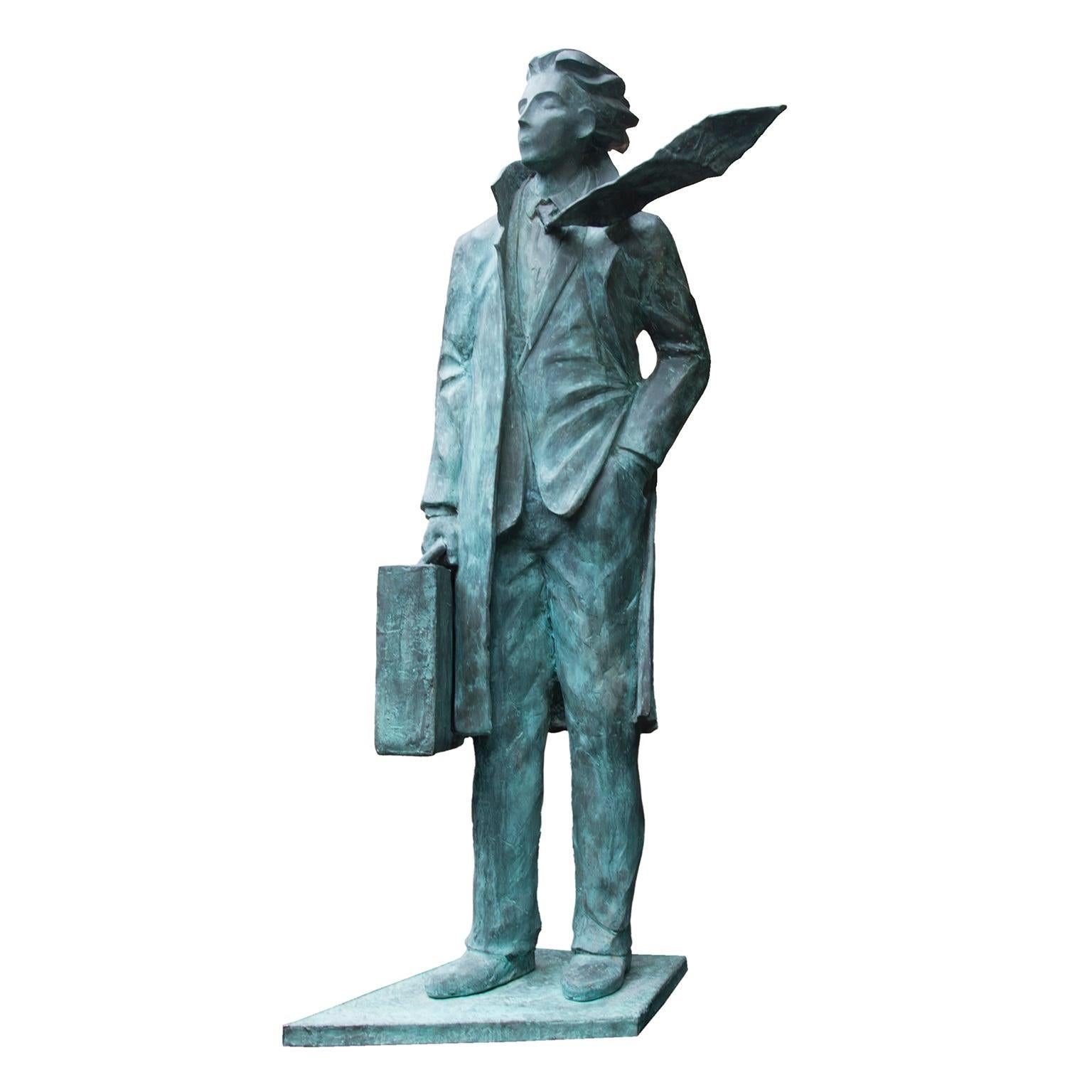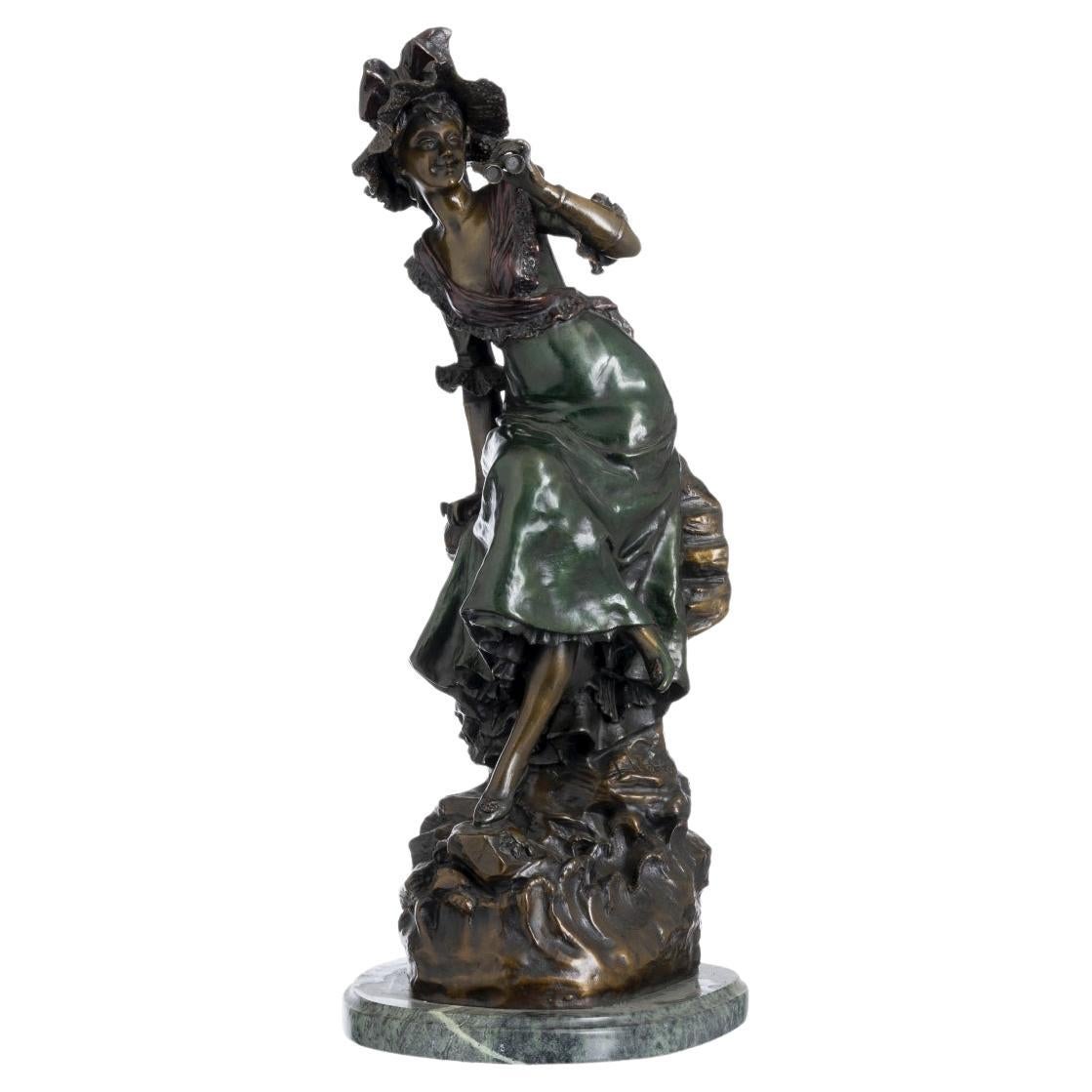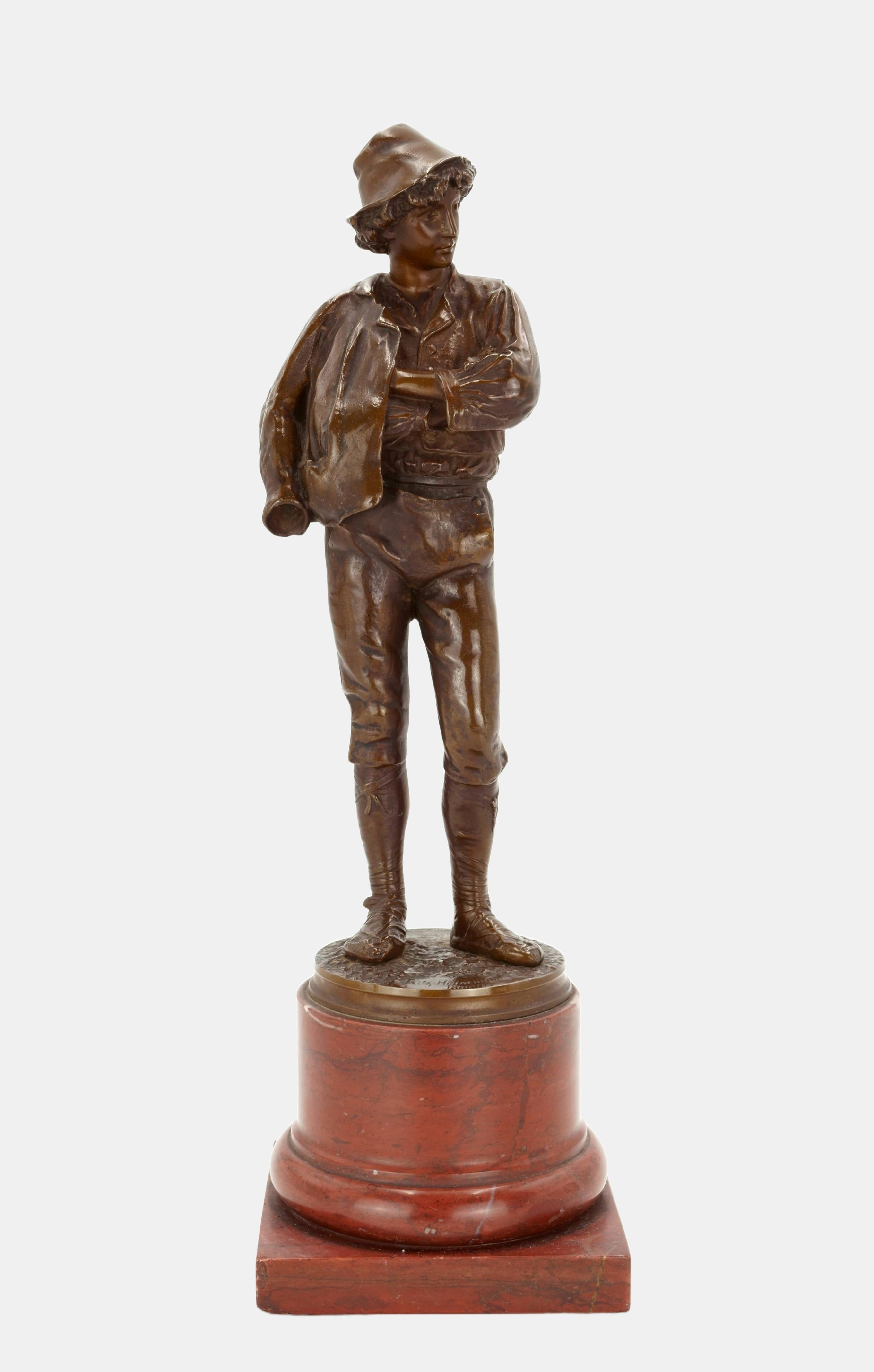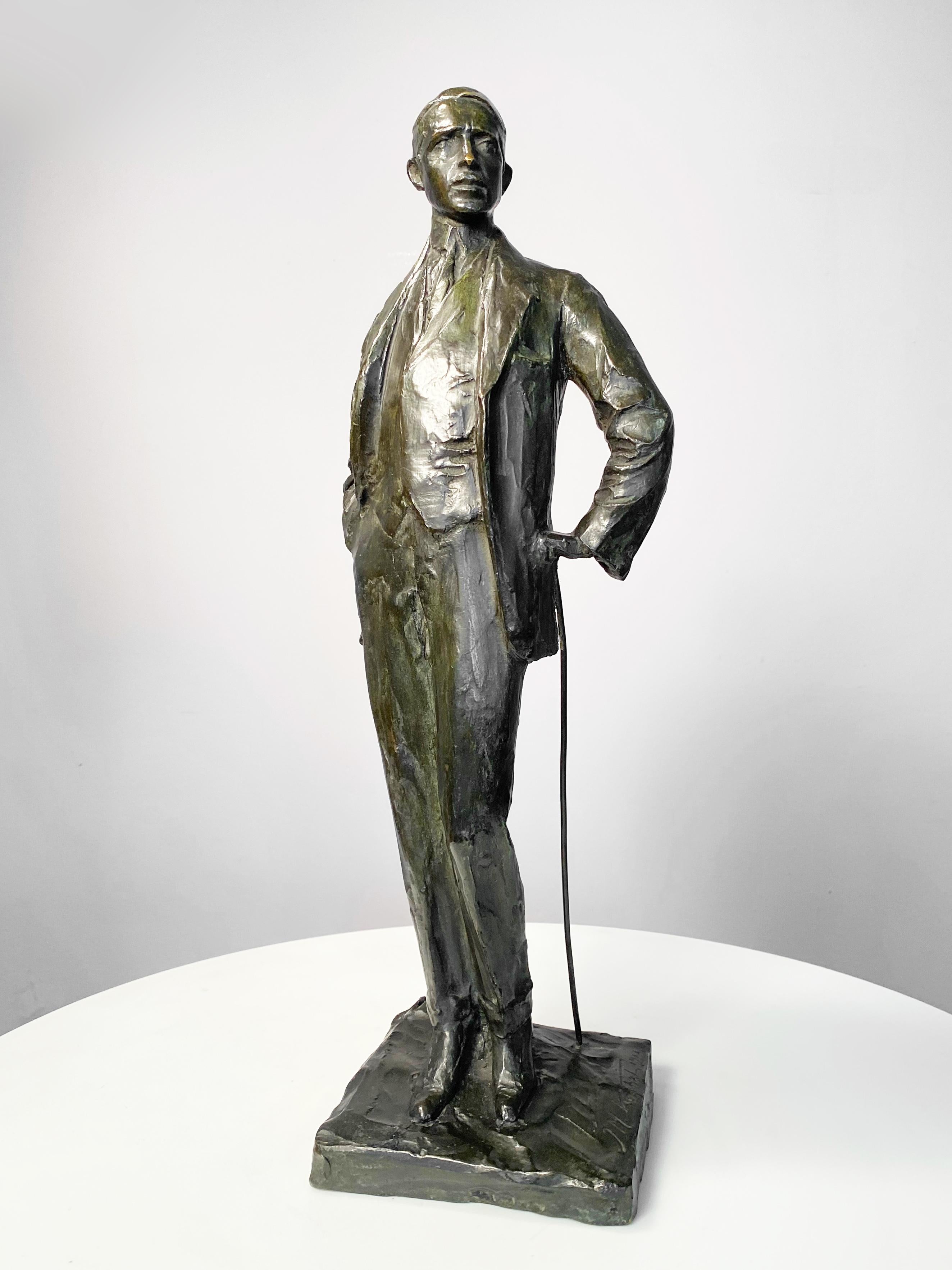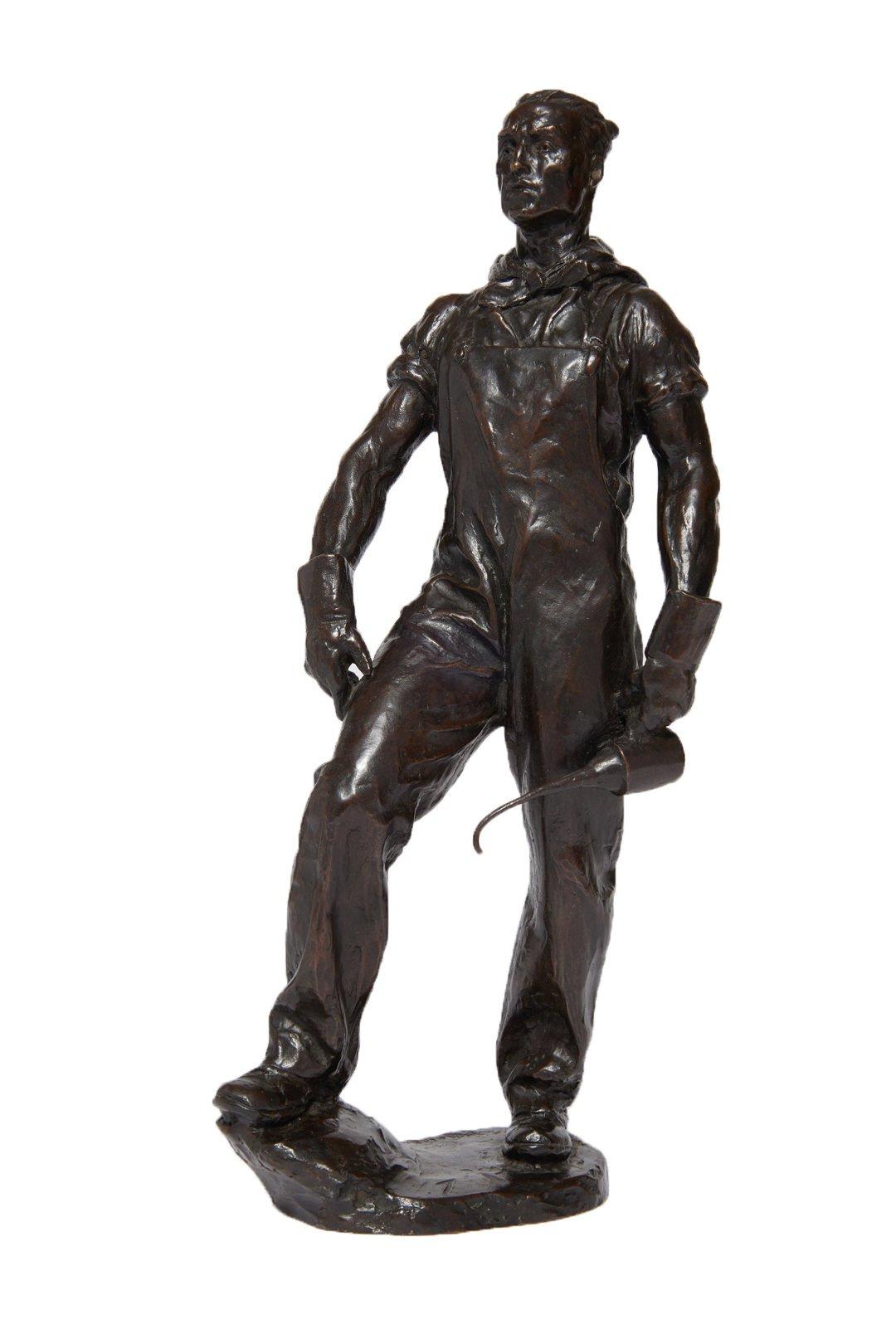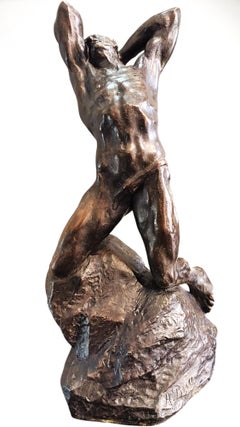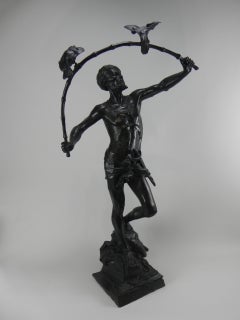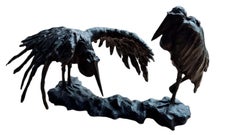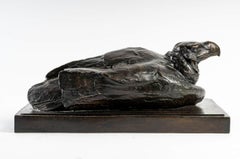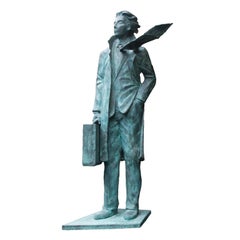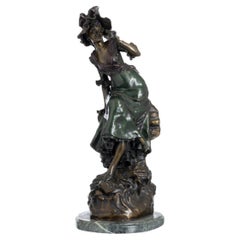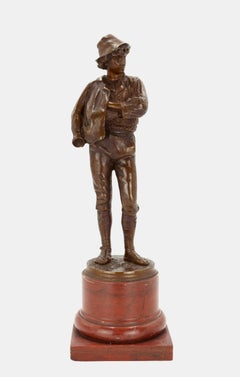Items Similar to Vagabond by Édouard Fortiny (Born in 1862)
Want more images or videos?
Request additional images or videos from the seller
1 of 8
Édouard FortinyVagabond by Édouard Fortiny (Born in 1862)20th century
20th century
$3,593.22
£2,662.77
€3,000
CA$4,905.43
A$5,457.09
CHF 2,860.67
MX$66,684.27
NOK 36,427.11
SEK 34,291.08
DKK 22,841.74
Shipping
Retrieving quote...The 1stDibs Promise:
Authenticity Guarantee,
Money-Back Guarantee,
24-Hour Cancellation
About the Item
Édouard Fortiny’s sculpture, "Vagabond", is a deeply emotive bronze piece that portrays a man from the margins of society. Standing at 28 cm, the sculpture captures the essence of a weary yet dignified figure, embodying themes of endurance, introspection, and quiet strength. Created in the late 19th or early 20th century, "Vagabond" is a reflection of Fortiny’s dedication to realism and his sensitivity to the human condition, qualities that elevate this work beyond mere genre art to something universal and timeless: It is a tribute to the resilience of the human spirit. Through his careful attention to detail and his sensitive portrayal of emotion, Fortiny transforms an ordinary figure into a powerful symbol of endurance and dignity. The sculpture’s realism and subtle emotional depth invite the viewer to reflect on their own experiences of struggle and perseverance, making "Vagabond" a timeless work that continues to speak to the enduring strength of the human condition.
The vagabond’s posture is relaxed but slightly slumped, suggesting a sense of weariness. His hands rest casually in his pockets, a gesture that evokes both resignation and self-possession. This subtle physical attitude indicates a man who is accustomed to hardship yet maintains his personal dignity. His clothing, simple and loose-fitting, evokes the attire of the working class or rural poor of the time, further anchoring the figure in the realism Fortiny was known for. The slightly slouched posture and hands-in-pockets stance give the sculpture a casual quality, but beneath this is an emotional depth that speaks to the weight of the vagabond’s life experience.
The figure’s head is bowed slightly, his gaze cast downward in contemplation. This subtle tilt of the head, combined with the weathered, rugged features of the man’s face, conveys a mood of introspection. The vagabond’s facial expression is particularly poignant. His eyes, partially closed and looking downward, convey a sense of deep thought or perhaps even melancholy. The lines etched into his face—particularly around his eyes and mouth—suggest a long life of toil and hardship, yet there is no bitterness in his expression. Instead, his demeanor suggests a quiet acceptance, a man who carries the burden of his life with a calm resolve. His beard and rough hair add to this impression of a man who has lived through difficulties but remains resilient in his own quiet way.
Fortiny’s attention to detail and realism is a hallmark of his work, and this sculpture is no exception. Every element of the figure—from the folds of his clothing to the texture of his skin and beard—is rendered with a fine attention to naturalism. This realism places the sculpture firmly within the genre art tradition, where ordinary people and scenes from everyday life are the subjects. Yet, Fortiny’s "Vagabond" goes beyond a simple depiction of an everyday figure; it captures the emotional and psychological state of the man, turning a humble figure into a universal representation of human struggle.
The vagabond’s clothing, though simple, are rendered with great care. These details help to create a vivid image of a man from the lower rungs of society, one who is perhaps overlooked in daily life but here given center stage. In choosing to depict such a figure, Fortiny draws attention to the plight of the poor and the marginalized, especially at a time when industrialization and modernization were leaving many people behind.
At the same time, the vagabond’s quiet strength and dignity suggest a universal message about human resilience. Despite his hardships, the man retains a sense of self-possession. His weariness does not define him; rather, it is his ability to endure that comes through most strongly. This resilience, captured so beautifully in the figure’s subtle posture and expression, makes "Vagabond" a timeless reflection on the human spirit.
Although "Vagabond" was created over a century ago, its themes of poverty, endurance, and quiet dignity remain relevant today. Fortiny’s ability to evoke such deep emotion through understated realism ensures that the sculpture resonates with modern viewers as much as it did when it was first created. In this way, Fortiny’s sculpture transcends the genre of everyday scenes to become a meditation on the human condition. The vagabond, standing quietly with his hands in his pockets, is not just a figure from history—he is a representation of all those who endure hardship with grace and quiet strength.
- Creator:Édouard Fortiny (1862)
- Creation Year:20th century
- Dimensions:Height: 11.03 in (28 cm)Width: 3.94 in (10 cm)
- Medium:
- Period:
- Condition:
- Gallery Location:Gent, BE
- Reference Number:1stDibs: LU2140215341762
About the Seller
5.0
Vetted Professional Seller
Every seller passes strict standards for authenticity and reliability
Established in 2018
1stDibs seller since 2022
5 sales on 1stDibs
Typical response time: 1 hour
- ShippingRetrieving quote...Shipping from: Gent, Belgium
- Return Policy
Authenticity Guarantee
In the unlikely event there’s an issue with an item’s authenticity, contact us within 1 year for a full refund. DetailsMoney-Back Guarantee
If your item is not as described, is damaged in transit, or does not arrive, contact us within 7 days for a full refund. Details24-Hour Cancellation
You have a 24-hour grace period in which to reconsider your purchase, with no questions asked.Vetted Professional Sellers
Our world-class sellers must adhere to strict standards for service and quality, maintaining the integrity of our listings.Price-Match Guarantee
If you find that a seller listed the same item for a lower price elsewhere, we’ll match it.Trusted Global Delivery
Our best-in-class carrier network provides specialized shipping options worldwide, including custom delivery.More From This Seller
View AllExtreme Effort - Powerful Bronze Sculpture by Alfredo Pina (1883-1966)
Located in Gent, VOV
Alfredo Pina’s Extreme Effort (Le Suprême Effort) is a striking bronze sculpture that embodies the raw struggle of human perseverance. This expressive work portrays a muscular male f...
Category
Early 20th Century Modern Nude Sculptures
Materials
Bronze
Auguste DE WEVER (1836-1910) Hindu Birdcatcher
Located in Gent, VOV
Hindu Birdcatcher
A fine quality, a nineteenth-century bronze cast of the Hindu bird-catcher standing on an elephant skull and holding two birds in the air which are sitting on a bambu stick by Auguste De Wever (Belgian 1836-1910). Old cast probably by the Compagnie des Bronzes foundry signed...
Category
19th Century Figurative Sculptures
Materials
Bronze
Guido Righetti Bronze Deux Marabouts africains (1914)
Located in Gent, VOV
This evocative double figure sculpture by Guido Righetti, titled Two African Marabous, is a masterful composition created in 1914. Depicting two marabou storks—a species often associ...
Category
20th Century Modern Figurative Sculptures
Materials
Bronze
Animal Bronze: Lying eagle by Alberic Collin (close friend of Rembrandt Bugatti)
Located in Gent, VOV
Numbered 1/8
Cast Fonderie Rocher
A fine cast with a vivid green patina of a bird of prey
Category
1930s Nude Sculptures
Materials
Bronze
Albéric CollinAnimal Bronze: Lying eagle by Alberic Collin (close friend of Rembrandt Bugatti), 1935
$17,355 Sale Price
25% Off
Young Bull Fighting – Bronze Sculpture by Guido Righetti (c. 1926)
Located in Gent, VOV
Guido The bronze patina, a rich dark brown with subtle reddish and golden undertones, enhances the sculpture’s texture and depth, accentuating the anatomy of the animal and evoking t...
Category
20th Century Modern Figurative Sculptures
Materials
Bronze
Thyl Ulenspiegel et Nele – Reduction of the Monument to Charles De Coster
Located in Gent, VOV
Charles Samuel – Thyl Ulenspiegel and Nele (after the Monument to Charles De Coster, 1894) Bronze, marble base, 66 x 61 x 27 cm Cast by Petermann, Brussels A moment of intimacy and d...
Category
20th Century Art Nouveau Figurative Sculptures
Materials
Marble, Bronze
You May Also Like
Original Work By Josep Campeny y Santamaria
Located in ROUEN, FR
"Original Work By Josep Campeny y Santamaria"
Statue of Josep Campeny y Santamaria who represents a Catalan worker, recognizable by his shovel, his caraco vest and his scarf on his h...
Category
20th Century Figurative Sculptures
Materials
Terracotta
Contemporary Art Bronze Sculpture Partenze by Giampaolo Talani
By Mirabili, Giampaolo Talani
Located in Pistoia, IT
Limited Edition of 8 Pieces.
Category
Early 2000s Italian Post-Modern Figurative Sculptures
Materials
Bronze
Louis Hottot (1834-1905)
By Louis Hottot
Located in Porto, PT
"Girl with Binoculars". Bronze sculpture on a marble base. Signed. Height: 63 cm.
Category
Antique 19th Century French Figurative Sculptures
Materials
Bronze
Young Roman / - Youthful Sprezzatura -
Located in Berlin, DE
Fritz Heinemann (1864 Altena - 1932 Berlin), Young Roman, 1892. Brownish patinated bronze on a cast round plinth, mounted on a red marble base (8.5 cm high), total height 36 cm, dime...
Category
1890s Realist Figurative Sculptures
Materials
Bronze
$862 Sale Price
20% Off
Portrait of a Gentleman
Located in Greenwich, CT
Nothing is more delightful than depictions of people from the turn of the century that convey a distinguished sort of elegance, composure and dignity. Gone today is the concept of "...
Category
1910s Realist Figurative Sculptures
Materials
Bronze
Locomotive Engineer, Early 20th Century Bronze Laborer, Cleveland School
By Max Kalish
Located in Beachwood, OH
Max Kalish (American, 1891-1945)
Locomotive Engineer, 1926
Bronze
Signed and dated on base, foundry mark: Meroni Radice Cire Perdue Paris
15.5 x 6 x 5 inches
Born in Poland March 1, 1891, figurative sculptor Max Kalish came to the United States in 1894, his family settling in Ohio. A talented youth, Kalish enrolled at the Cleveland Institute of Art as a fifteen-year-old, receiving a first-place award for modeling the figure during studies with Herman Matzen. Kalish went to New York City following graduation, studying with Isidore Konti and Herbert Adams...
Category
1920s Figurative Sculptures
Materials
Bronze

